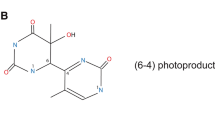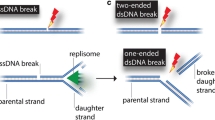Abstract
Much of the cancer-causing effects of ultraviolet radiation from the sun have been linked to the formation of dimerized DNA bases. These dimeric DNA photoproducts include the cyclobutane pyrimidine dimers (CPDs) and the pyrimidine(6-4)pyrimidone photoproducts [(6-4)PPs]. CPDs are highly mutagenic and are produced in substantial quantities by UVB radiation. These dimers can form between any two adjacent pyrimidines and can involve thymine, cytosine, or 5-methylcytosine. Very recently, a sixth DNA base, 5-hydroxymethylcytosine (5hmC) has been identified and characterized as a normal component of mammalian DNA. Here, we investigated the formation of CPDs at different DNA sequences containing 5hmC following irradiation with UVA, UVB, or UVC light sources. We show that the formation of CPDs at dipyrimidines containing 5hmC occurs at different DNA sequences but is not enhanced relative to cytosine or 5-methylcytosines at the same sequence positions. In fact, in some sequence contexts, CPDs containing 5hmC are formed at very low levels. Nonetheless, CPD formation at 5hmC pyrimidines is expected to be biologically relevant since three types of human skin-derived cells, fibroblasts, keratinocytes and melanocytes, all contain detectable levels of this modified base.
Similar content being viewed by others
References
J. Cadet, T. Douki, Oxidatively generated damage to DNA by UVA radiation in cells and human skin, J. Invest. Dermatol., 2011, 131, 1005–1007.
T. Douki, A. Reynaud-Angelin, J. Cadet, E. Sage, Bipyrimidine photoproducts rather than oxidative lesions are the main type of DNA damage involved in the genotoxic effect of solar UVA radiation, Biochemistry, 2003, 42, 9221–9226.
G. P. Pfeifer, Y. H. You, A. Besaratinia, Mutations induced by ultraviolet light, Mutat. Res., 2005, 571, 19–31.
P. J. Rochette, J. P. Therrien, R. Drouin, D. Perdiz, N. Bastien, E. A. Drobetsky, E. Sage, UVA-induced cyclobutane pyrimidine dimers form predominantly at thymine-thymine dipyrimidines and correlate with the mutation spectrum in rodent cells, Nucleic Acids Res., 2003, 31, 2786–2794.
N. Bastien, J. F. Millau, M. Rouabhia, R. J. Davies, R. Drouin, The sunscreen agent 2-phenylbenzimidazole-5-sulfonic acid photosensitizes the formation of oxidized guanines in cellulo after UV-A or UV-B exposure, J. Invest. Dermatol., 2010, 130, 2463–2471.
D. L. Mitchell, A. A. Fernandez, Different types of DNA damage play different roles in the etiology of sunlight-induced melanoma, Pigm. Cell Melanoma Res., 2011, 24, 119–124.
Y. H. You, D. H. Lee, J. H. Yoon, S. Nakajima, A. Yasui, G. P. Pfeifer, Cyclobutane pyrimidine dimers are responsible for the vast majority of mutations induced by UVB irradiation in mammalian cells, J. Biol. Chem., 2001, 276, 44688–44694.
D. L. Mitchell, R. S. Nairn, The biology of the (6-4) photoproduct, Photochem. Photobiol., 1989, 49, 805–819.
D. H. Lee, G. P. Pfeifer, Deamination of 5-methylcytosines within cyclobutane pyrimidine dimers is an important component of UVB mutagenesis, J. Biol. Chem., 2003, 278, 10314–10321.
J. H. Choi, G. P. Pfeifer, The role of DNA polymerase eta in UV mutational spectra, DNA Repair, 2005, 4, 211–220.
N. Jiang, J.-S. Taylor, In vivo evidence that UV-induced C-T mutations at dipyrimidine sites could result from the replicative bypass of cis-syn cyclobutane dimers or their deamination products, Biochemistry, 1993, 32, 472–481.
B. Vu, V. J. Cannistraro, L. Sun, J. S. Taylor, DNA synthesis past a 5-methylC-containing cis-syn-cyclobutane pyrimidine dimer by yeast pol eta is highly nonmutagenic, Biochemistry, 2006, 45, 9327–9335.
E. Sage, B. Lamolet, E. Brulay, E. Moustacchi, A. Chteauneuf, E. A. Drobetsky, Mutagenic specificity of solar UV light in nucleotide excision repair-deficient rodent cells, Proc. Natl. Acad. Sci. U. S. A., 1996, 93, 176–180.
Y.-H. You, C. Li, G. P. Pfeifer, Involvement of 5-methylcytosine in sunlight-induced mutagenesis, J. Mol. Biol., 1999, 293, 493–503.
D. E. Brash, J. A. Rudolph, J. A. Simon, A. Lin, G. J. McKenna, H. P. Baden, A. J. Halperin, J. Pontén, A role for sunlight in skin cancer: UV-induced p53 mutations in squamous cell carcinoma, Proc. Natl. Acad. Sci. U. S. A., 1991, 88, 10124–10128.
N. Dumaz, C. Drougard, A. Sarasin, L. Daya-Grosjean, Specific UV-induced mutation spectrum in the p53 gene of skin tumors from DNA-repair-deficient xeroderma pigmentosum patients, Proc. Natl. Acad. Sci. U. S. A., 1993, 90, 10529–10533.
G. P. Pfeifer, Environmental exposures and mutational patterns of cancer genomes, Genome Med., 2010, 2, 54.
E. Hodis, I. R. Watson, G. V. Kryukov, S. T. Arold, M. Imielinski, J. P. Theurillat, E. Nickerson, D. Auclair, L. Li, C. Place, D. Dicara, A. H. Ramos, M. S. Lawrence, K. Cibulskis, A. Sivachenko, D. Voet, G. Saksena, N. Stransky, R. C. Onofrio, W. Winckler, K. Ardlie, N. Wagle, J. Wargo, K. Chong, D. L. Morton, K. Stemke-Hale, G. Chen, M. Noble, M. Meyerson, J. E. Ladbury, M. A. Davies, J. E. Gershenwald, S. N. Wagner, D. S. Hoon, D. Schadendorf, E. S. Lander, S. B. Gabriel, G. Getz, L. A. Garraway, L. Chin, A landscape of driver mutations in melanoma, Cell, 2012, 150, 251–263.
S. Tommasi, M. F. Denissenko, G. P. Pfeifer, Sunlight induces pyrimidine dimers preferentially at 5-methylcytosine bases, Cancer Res., 1997, 57, 4727–4730.
R. Drouin, J. P. Therrien, UVB-induced cyclobutane pyrimidine dimer frequency correlates with skin cancer mutational hotspots in p53, Photochem. Photobiol., 1997, 66, 719–726.
G. R. Wyatt, S. S. Cohen, The bases of the nucleic acids of some bacterial and animal viruses: the occurrence of 5-hydroxymethylcytosine, Biochem. J., 1953, 55, 774–782.
S. Kriaucionis, N. Heintz, The nuclear DNA base 5-hydroxymethylcytosine is present in Purkinje neurons and the brain, Science, 2009, 324, 929–930.
M. Tahiliani, K. P. Koh, Y. Shen, W. A. Pastor, H. Bandukwala, Y. Brudno, S. Agarwal, L. M. Iyer, D. R. Liu, L. Aravind, A. Rao, Conversion of 5-methylcytosine to 5-hydroxymethylcytosine in mammalian DNA by MLL partner TET1, Science, 2009, 324, 930–935.
S. Ito, A. C. D’Alessio, O. V. Taranova, K. Hong, L. C. Sowers, Y. Zhang, Role of Tet proteins in 5mC to 5hmC conversion, ES-cell self-renewal and inner cell mass specification, Nature, 2010, 466, 1129–1133.
K. Iqbal, S. G. Jin, G. P. Pfeifer, P. E. Szabo, Reprogramming of the paternal genome upon fertilization involves genome-wide oxidation of 5-methylcytosine, Proc. Natl. Acad. Sci. U. S. A., 2011, 108, 3642–3647.
S. G. Jin, X. Wu, A. X. Li, G. P. Pfeifer, Genomic mapping of 5-hydroxymethylcytosine in the human brain, Nucleic Acids Res., 2011, 39, 5015–5024.
A. Szwagierczak, S. Bultmann, C. S. Schmidt, F. Spada, H. Leonhardt, Sensitive enzymatic quantification of 5-hydroxymethylcytosine in genomic DNA, Nucleic Acids Res., 2010, 38, e181.
J. D. Childs, M. C. Paterson, B. P. Smith, N. E. Gentner, Evidence for a near UV-induced photoproduct of 5-hydroxymethylcytosine in bacteriophage T4 that can be recognized by endonuclease V, Mol. Gen. Genet., 1978, 167, 105–112.
J. D. Childs, M. J. Ellison, R. Pilon, Formation of 5-hydroxymethylcytosine-containing pyrimidine dimers in UV-irradiated bacteriophage T4 DNA, Photochem. Photobiol., 1983, 37, 513–519.
R. Meneghini, P. Hanawalt, T4-endonuclease V-sensitive sites in DNA from ultraviolet-irradiated human cells, Biochim. Biophys. Acta, 1976, 425, 428–437.
S. G. Jin, S. Kadam, G. P. Pfeifer, Examination of the specificity of DNA methylation profiling techniques towards 5-methylcytosine and 5-hydroxymethylcytosine, Nucleic Acids Res., 2010, 38, e125.
S. G. Jin, Y. Jiang, R. Qiu, T. A. Rauch, Y. Wang, G. Schackert, D. Krex, Q. Lu, G. P. Pfeifer, 5-Hydroxymethylcytosine is strongly depleted in human cancers but its levels do not correlate with IDH1 mutations, Cancer Res., 2011, 71, 7360–7365.
Q. Song, V. J. Cannistraro, J. S. Taylor, Rotational position of a 5-methylcytosine-containing cyclobutane pyrimidine dimer in a nucleosome greatly affects its deamination rate, J. Biol. Chem., 2011, 286, 6329–6335.
Y. Tu, R. Dammann, G. P. Pfeifer, Sequence and time-dependent deamination of cytosine bases in UVB-induced cyclobutane pyrimidine dimers in vivo, J. Mol. Biol., 1998, 284, 297–311.
L. Celewicz, M. Mayer, M. D. Shetlar, The photochemistry of thymidylyl-(3’-5’)-5-methyl-2’-deoxycytidine in aqueous solution, Photochem. Photobiol., 2005, 81, 404–418.
C. Frauer, T. Hoffmann, S. Bultmann, V. Casa, M. C. Cardoso, I. Antes, H. Leonhardt, Recognition of 5-hydroxymethylcytosine by the Uhrf1 SRA domain, PLoS One, 2011, 6, e21306.
O. Yildirim, R. Li, J. H. Hung, P. B. Chen, X. Dong, L. S. Ee, Z. Weng, O. J. Rando, T. G. Fazzio, Mbd3/NURD complex regulates expression of 5-hydroxymethylcytosine marked genes in embryonic stem cells, Cell, 2011, 147, 1498–1510.
M. Mellen, P. Ayata, S. Dewell, S. Kriaucionis, N. Heintz, MeCP2 binds to 5hmC enriched within active genes and accessible chromatin in the nervous system, Cell, 2012, 151, 1417–1430.
C. G. Spruijt, F. Gnerlich, A. H. Smits, T. Pfaffeneder, P. W. Jansen, C. Bauer, M. Munzel, M. Wagner, M. Muller, F. Khan, H. C. Eberl, A. Mensinga, A. B. Brinkman, K. Lephikov, U. Muller, J. Walter, R. Boelens, H. van Ingen, H. Leonhardt, T. Carell, M. Vermeulen, Dynamic readers for 5-(hydroxy)methylcytosine and its oxidized derivatives, Cell, 2013, 152, 1146–1159.
G. P. Pfeifer, R. Drouin, A. D. Riggs, G. P. Holmquist, Binding of transcription factors creates hot spots for UV photoproducts in vivo, Mol. Cell. Biol., 1992, 12, 1798–1804.
S. Tornaletti, G. P. Pfeifer, UV light as a footprinting agent: modulation of UV-induced DNA damage by transcription factors bound at the promoters of three human genes, J. Mol. Biol., 1995b, 249, 714–728.
Author information
Authors and Affiliations
Corresponding author
Rights and permissions
About this article
Cite this article
Kim, Si., Jin, SG. & Pfeifer, G.P. Formation of cyclobutane pyrimidine dimers at dipyrimidines containing 5-hydroxymethylcytosine. Photochem Photobiol Sci 12, 1409–1415 (2013). https://doi.org/10.1039/c3pp50037c
Received:
Accepted:
Published:
Issue Date:
DOI: https://doi.org/10.1039/c3pp50037c




